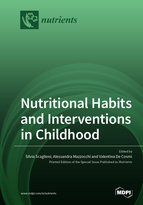Nutritional Habits and Interventions in Childhood
A special issue of Nutrients (ISSN 2072-6643). This special issue belongs to the section "Pediatric Nutrition".
Deadline for manuscript submissions: closed (20 December 2021) | Viewed by 118266
Special Issue Editors
Interests: early risk factors for obesity development; factors influencing children’s eating behaviors; nutritional habits in infants and children; dietary intervention in children obesity; determinants of early childhood caries
Interests: human nutrition; metabolism; body composition; nutritional status
2. Fondazione IRCCS Ca’ Granda Ospedale Maggiore Policlinico, Pediatric Intermediate Care Unit, 20122 Milan, Italy
Interests: pediatric obesity; human nutrition; metabolism; nutritional epidemiology; artificial neural networks implementation to predict resting energy expenditure; fatty acids analysis
Special Issues, Collections and Topics in MDPI journals
Special Issue Information
Dear Colleagues,
We are pleased to invite contributions of original research or reviews to extend our understanding of how food preferences change throughout life, under the influence of biological, social, and environmental factors. The objective of this proposed Special Issue on “Nutritional Habits and Interventions in Childhood” is to publish selected papers about nutritional and educational interventions towards children and their families. The creation of healthy preferences are key determinants of food choices, and therefore diet quality. Children and adolescents with chronic or inflammatory disease are more vulnerable and are at major risk of developing malnutrition. For this reason, nutritional interventions tailored to specific pathologies are needed to prevent nutritional deficiencies and to maintain an adequate nutritional status. Nutrition has also a therapeutic effect and may modulate risk factors for specific pathologies. We invite you to submit your research covering these important topics. Submission of original papers, reviews, or meta-analyses are particularly welcome.
Dr. Silvia Scaglioni
Guest Editor
Dr. Alessandra Mazzocchi
Dr. Valentina De Cosmi
Co-Guest Editors
Manuscript Submission Information
Manuscripts should be submitted online at www.mdpi.com by registering and logging in to this website. Once you are registered, click here to go to the submission form. Manuscripts can be submitted until the deadline. All submissions that pass pre-check are peer-reviewed. Accepted papers will be published continuously in the journal (as soon as accepted) and will be listed together on the special issue website. Research articles, review articles as well as short communications are invited. For planned papers, a title and short abstract (about 100 words) can be sent to the Editorial Office for announcement on this website.
Submitted manuscripts should not have been published previously, nor be under consideration for publication elsewhere (except conference proceedings papers). All manuscripts are thoroughly refereed through a single-blind peer-review process. A guide for authors and other relevant information for submission of manuscripts is available on the Instructions for Authors page. Nutrients is an international peer-reviewed open access semimonthly journal published by MDPI.
Please visit the Instructions for Authors page before submitting a manuscript. The Article Processing Charge (APC) for publication in this open access journal is 2900 CHF (Swiss Francs). Submitted papers should be well formatted and use good English. Authors may use MDPI's English editing service prior to publication or during author revisions.
Keywords
- early food preferences
- feeding strategy
- dietary habits
- disease-related malnutrition
- educational intervention
- nutritional intervention
- obesity in childhood







